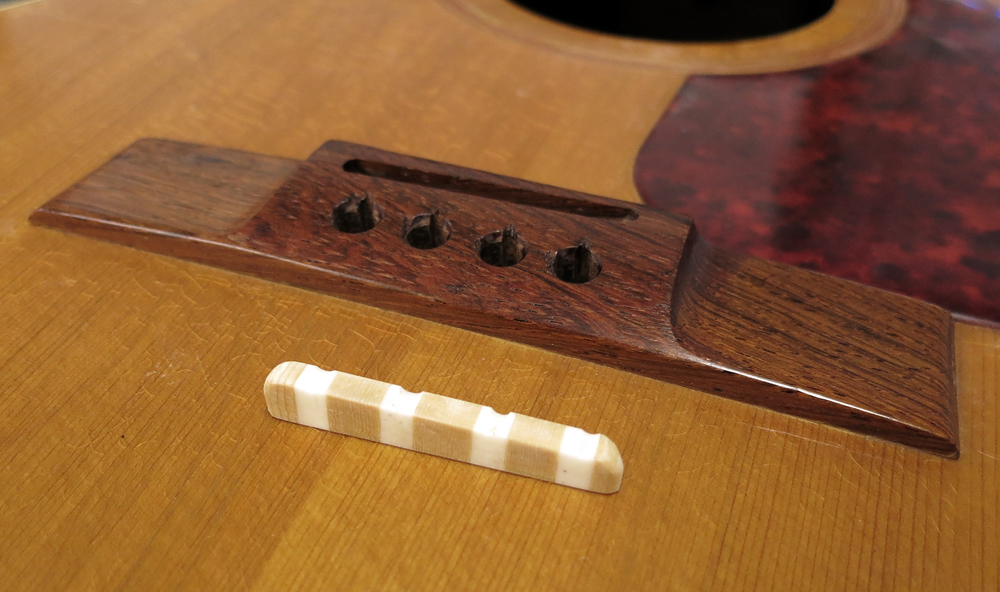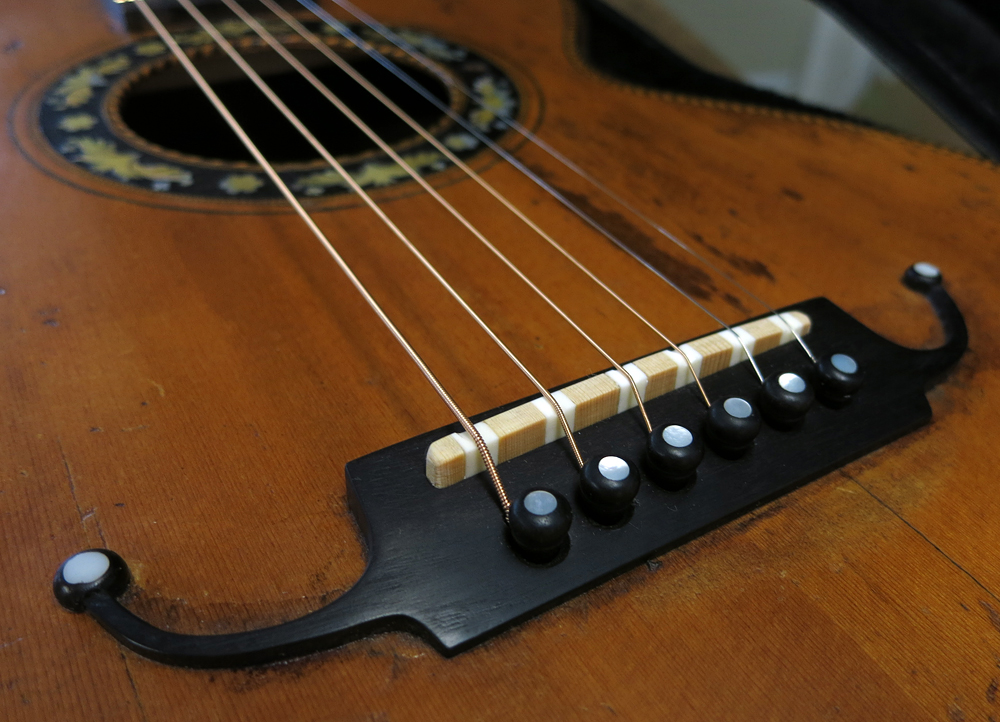This is my first post on this nice forum and I have something new to tell you that actually changes the tone of any acoustic guitar and in my opinion in a good way. This is a bold statement I know. I was amazed myself that there is still such a thing to discover! Here it is (an early tenor guitar one without the shim in the bottom).
I call it a "composite saddle bone" (CSB). It's made of solid bone posts, one under each string, with the same wood as in the top of the guitar in between the bone posts and a thin shim of the same wood as in the bridge in the bottom. Everything glued and soaked with thin CA glue. The bone posts are 5 mm wide and the thickness of the CSB is typically 4 mm. The wood is soaked with CA to make it harder and the shim in the bottom keeps the pieces together. It is the bone posts that takes the whole load from the strings, bone is very hard indeed. With a tight fit in the saddle channel (with some paste wax to make it easy to remove without breaking it) there is no structural problem.
There you have it. So what does it do? Here is a list of the good things I have noted.
* You get better string separation. When you strum a chord the sound is more "grainy", you can hear more of the individual strings in the sound.
* The sound is not as harsh as with a solid bone. At first you think the volume is lower, but after playing a while you realize that the volume is there, only spread in a wider frequency range.
* Less problems with wolf notes.
* A tad less sustain makes single notes stand out more.
Some things may be negative.
* The sound is not what you are used to.
* It's impossible to be angry with the guitar. Everything sounds so nice even when you strum very hard.
* The volume is spread over a wider range and don't cut like a solid bone saddle.
I have been making CSB's for more than a year now. I do restorations and improvements of old steel stringed parlor guitars for a living. The concept is called "GammelGura" ("OldGuitar") and I have a site www.gammelgura.se with a lot of slides and text in Swedish to check out.
I love the balanced and beautiful sound of steel strings with ladder bracing and don't care that much for big X braced guitars or plastic string guitars. My aim is a varied and interesting tone and an instrument that plays well and in tune. The CSB is exactly in my taste.
I have some theories I will share with you. They may even be correct.
The reason for the better separation must come from the fact that every string is separated with soft spruce/cedar. Every bone post can vibrate more individually for each string compared with a solid bone.
Why I say that you should have the same wood in the composite bone as in the top is a result of my experiments with different woods. I tried different hard woods and they didn't sound nearly as good as spruce and cedar (but still better than a solid bone saddle). Having cedar in the bone and spruce in the top gave an interesting and darker sound, but somehow it felt like the two sounds clashed with each other. With the same wood as in the top I got "extra everything". I believe that the frequency recipe is preshaped "the spruce/cedar way" when vibrations travels through the wood parts of the CSB before it hits the top. I can assure you that the difference in sound from the CSB is very audible with different woods. The wood in the shim on the bottom of the saddle bone should be the same as in the bridge, effectively just lowering the active part of the CSB.
When doing research on the net I found a couple of similar things done, but for other reasons. One maker uses a different and harder material than bone in small inserts under the strings in an all wooden saddle bone. The main thing here is the new material. Some banjo bridges use harder ebony inserts under the strings in a softer maple bridge. People have cut the solid saddle bone in pieces to get a better and more even signal from the under saddle pickup, one of them mentioned as a side note that the guitar "sounded better"! Others has put separate bone posts directly in the bridge but failed to notice the separation effect (they probably thought that the guitar sounded good due to something else!).
I do make one variation of the CSB. I cut a solid saddle bone between the strings all the way with a wood shim in the bottom to hold the pieces together. Leaving separate wide bone posts with a void as wide as the saw in between. With that one I get the better string separation, but a cutting sound that is more like the sound from a solid saddle bone. I prefer that solution on modern X-braced guitars.
It's not that hard to do the CSB. I start off with a bigger piece of standing grain spruce with the right thickness and do square cuts for the bone posts (longer than needed) with my small bandsaw on one side. Then I CA glue the bone posts into the spruce cuts and cut the whole CSB to the right height and width with the band saw. I have described the process in pictures and Swedish here: http://gammelgura.se/wordpress/?page_id=1984
The cut up solid saddle bone is very simple indeed to make.
I would love to hear some opinions from someone curious enough to do the experiment :-)
Views: 861
Replies to This Discussion
-
It looks impressive! When soaking the wood between the bone with super glue I would think would be harder than the bone.
Ron
-
No it is still brittle, the glue dont fill the whole wood structure. But it's harder and I haven't heard a big difference in tone compared to the raw wood. Cedar is way softer than spruce and breaks easily even when soaked with superglue. That's why I put a shim in the bottom now to help keep the bone together.
When mounted in the saddle ditch with a nice tight fit the saddle bone is strong . But it helps to have the bone a bit thicker than normal, I always do a nut intonation too and most of the time the saddle needs to be 4 mm thick to be able to reach all the intonation points in the saddle anyway.
-
Some slides of how to do a composite saddle bone.
It all starts with a dummy "saddlebone" in spruce to give me the measures where to put the center of the bone posts. Pencil markings on the sides of the strings (now removed).A slice of tight grain spruce is made a bit thicker than the saddle will be.
The bone posts are cut with a hacksaw from a solid bone sized to 5 mm thickness in the thickness sander. The even 5 mm side will be in the direction of the bone.
The measures from the dummy spruce "saddlebone" is used to mark where wood will be cut away.
The cut outs for the bone posts are made with a small bandsaw.
The bone posts are glued in with superglue. I use a gas mask and disposable gloves when doing this! Some plastic wrap to work on.
The CSB is sized to the right thickness.
Soaked the bone with thin superglue and cut it to te length of the slot.
Cut it to the aproximate height.
Sanding to lower height after stringing up and adjusting the nut.
The finished saddle bone with a wooden shim in the bottom. Some paste wax on it to make it easy to remove from the slot.
© 2025 Created by Frank Ford.
Powered by
![]()

